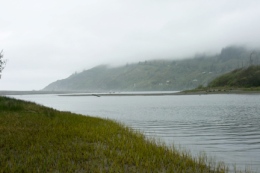Electricity provider PacifiCorp’s dams prevent salmon from reaching 350 miles of habitat upstream in the Klamath River to spawn. The Klamath salmon fishery all but collapsed, and commercial fishing is restricted.
PacifiCorp conceded to negotiate dam removal in November 2008 after years of protest by affected parties. The company’s 50-year license expired in 2000 and relicensing requires an array of costly bureaucratic processes.
Negotiators include PacifiCorp, Klamath River basin tribes, farmers, ranchers, conservation and fishing groups, various counties, California, Oregon and Federal government agencies. They hope to reach a final agreement by June 30, 2009.
According to Craig Tucker, a Klamath campaign coordinator for the Karuk Tribe, the state of California would like to connect funding for dam removal to a package that would build more dams in other parts of the state. This would be funded by a water bond which voters would have to approve.
“I don’t see something like that as being a very secure way to fund restoration of the Klamath river, so we have to convince Gov. Schwarzenegger that fixing the Klamath is not destroying other rivers,” he said.
Tucker believes bipartisan support in congress is necessary and possible with assurances for farmers that they can continue to make a living. He considers this “the biggest river restoration effort in the history of the world.”
Another criticism according to Erica Terence, board of directors member for Klamath Riverkeeper, is that the agreement, in principle, has at least 14 or 15 ways for people who sign the agreement to back out and say “deals off,” and that can happen at various points along the way.
If an agreement is reached, Terence said removal of the dams on the Klamath would not occur until 2020.
Klamath Riverkeeper is not part of the negotiations, but has strong opinions about what needs to change in the draft agreement to make it acceptable. Their mission is to “restore water quality and fisheries throughout the Klamath watershed, bringing vitality and abundance back to the river and its people.”
The Klamath watershed is home to diverse indigenous cultures. If the salmon die off, so does their way of life. “These are major issues we are talking about, livelihoods in commercial fishing, lost profits and a lot of people are proud of the salmon culture,” Terence said.
One controversial provision in the
current agreement draft protects
PacifiCorp from liability.
Marlon Sherman, HSU Native American
studies professor, said, “I’m surprised
at the willingness of three of the four
tribes to waive their right to sue over
past injustices.”
Sherman continued that those three
tribes are busy being good neighbors and
smooth negotiators. “They would be
better if they change their position to
be strongly assertive of tribal
sovereign rights.”
Because tribes cannot sustain themselves from the river, they must rely on foreign food sources, which endangers their financial and physical health. Terrance believes the situation could lead to poverty, diabetes and cultural genocide.
Toxic blue-green algae, Microcystis aeruginosa, is flourishing in the dam’s stagnant reservoirs. The algae excretes the toxin microcystin, found in recreational areas along the reservoir up to 4,000 times the level considered a moderate health risk according to the World Health Organization.
Eye and skin irritation, vomiting, stomach cramps, diarrhea, fever, headache, pains in muscles and joints and weakness are some side effects of exposure. Chronic exposure can lead to liver failure or cancer.
For children, swallowing a mouthful
of microcystin-rich water equates to
hundreds of times over the limits for
daily exposure. Elderly people and pets
are also more susceptible.
Terence said that despite being “a good
decision scientifically, for political
reasons the U.S. Secretary of the
Interior could deny our ability to take
the dams out.”
Terence said currently the Klamath Riverkeeper’s priority is getting support and organizing for the upcoming PacifiCorp annual shareholder meeting in Omaha, Nebra., on May 1.
Comments
Riverkeeper claims to be not at the table of the KBRA/Klamath Basin Restoration Agreement in your article.
Karuk Spokesman Craig Tucker is at the KBRA table with the Karuk Tribe
Petey Brucker is at the table with Klamath Forest Alliance
Leaf Hillman is at the table with the Karuk Tribe
And all three are on the Klamath Riverkeeper board of directors. HERE
In the KBRA, the parties at the secret talks are not supposed to criticize other parties or the KBRA since they claim to be friends in this agreement. So they do it in the guise of another group not at the table, while they are on the board and helped create Klamath Riverkeeper.

